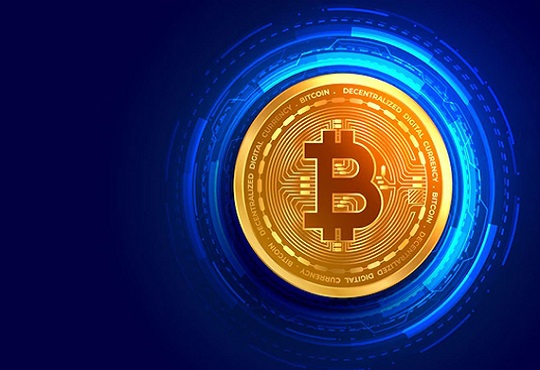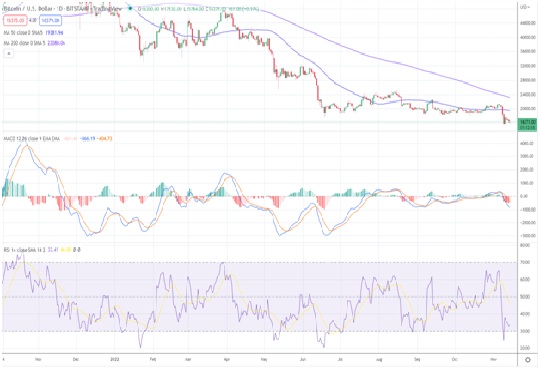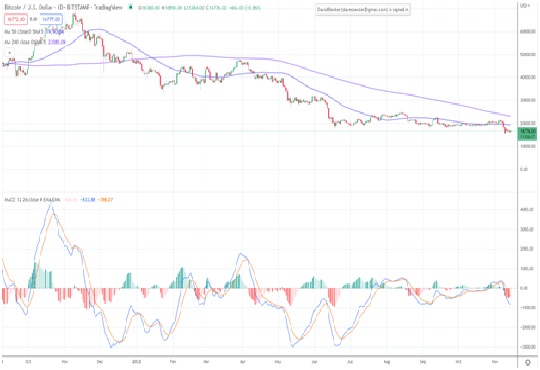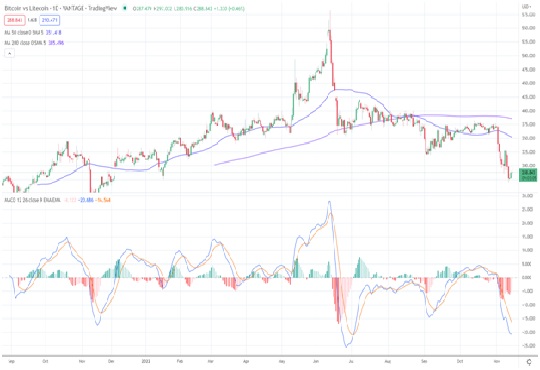Optimistic Investors Still Believe in Bitcoin Despite Lagging Other Altcoins
John, content writer | Tuesday, 06 December 2022, 08:29 IST

Bitcoin prices have dropped sharply in 2022, trending lower, declining about $30,000 or 65% since the beginning of the year (see chart below). The decline in the value of the digital currency is likely because of several factors. Rising interest rates, the rise in the value of the U.S. dollar as well as the sharp drop in riskier assets are a few. Altcoins like Ether and Litcoin have outperformed Bitcoin in 2022 (see chart below). Still, despite the underperformance of Bitcoin, investors remain optimistic that the fundamentals associated with digital currencies and blockchain will continue to buoy the most liquid cryptocurrency.
What are Bitcoin and Altcoins?
Bitcoin is the most liquid cryptocurrency worldwide. It's a payment mechanism that uses a decentralized means to create coins. Unlike a central bank printing currency to support a country, Bitcoin is created when a transaction is verified. Each time a new transaction occurs, a Bitcoin miner verifies the transaction on the bitcoin blockchain and receives Bitcoin for verification. A central bank does not control coins. When a country wants to increase exports, it cannot decrease the value of Bitcoin to make the goods and services produced in their country less expensive and more attractive to consumers abroad.
Altcoins are usually defined as cryptocurrencies other than Bitcoin. Some altcoins use a validation method similar to Bitcoin called proof of work. The alternative is called proof of stake. The proof of work concept that started with Bitcoin is a process in which a complex algorithm is solved to generate a verification of a transaction. The problem generally requires a significant amount of electricity and computer power. The proof of work process is a decentralized consensus mechanism used to validate a transaction and mine new cryptocurrency coins.
An alternative to proof of work is proof of stake, which is used in several altcoin environments. Proof of stake can also be used for blockchain cryptocurrencies and is a consensus mechanism for validating transactions. Instead of having to solve a complex transaction, the validator needs to be able to show they own a certain amount of cryptocurrency. The verification is based on several staked coins allowing the holder of those coins to be a verifier or miner of new coins.
Both Bitcoin and Altcoins can be used as a store of value. They are considered by some an asset and can also be used as a payment mechanism. Some altcoins, such as Ether, are used to pay for projects created on the Ethereum platform.
How Has Bitcoin Perform Relative to Altcoins
2002 has been a rough year for Bitcoin. The exchange rate relative to the U.S. dollar tumbled from about 46,200 to nearly 16,000, a drop of 65% (see chart). Altcoins have also not faired well. They have also declined, but their decrease has not been as significant. Ether fell from nearly 3,600 to approximately 1,200 (see chart).
To determine how altcoins performed relative to Bitcoin, you can generate a chart of the ratio of Bitcoin to different altcoins. For example, the chart BTC/LTC shows you how the ratio between Bitcoin and Litecoin performed over time. The change in the ratio over the year showed some volatility, but the change has been relatively tame, meaning that both cryptocurrencies have declined more than 60% slightly over 2022. In May, the relative outperformance of Bitcoin over Litecoin hit a high.
The Decline in Riskier Assets
Bitcoin prices can be considered a representation of the risk-on trade. Generally, volatile products will attract investments when interest rates are moving lower, and investors are willing to move out on the risk spectrum, looking for higher returns. Like stock prices, Bitcoin prices rose as the Fed continued cutting interest rates. When the Fed turned hawkish and drove up interest rates, the tide turned to put downward pressure on Bitcoin prices. As investors started to price more interest rate hikes, investors also became concerned that economic growth would begin to stagnate.
Unfortunately, the Fed hikes rates to slow economic growth and drive down wages. Lower incomes will reduce other prices as consumer demand starts to dry up.
The Dollar Rallies
While Bitcoin can be exchanged versus many different fiat currencies, the U.S. dollar is the top fiat currency used in Bitcoin trading. Approximately 85%f the Bitcoin that is traded is exchanged versus the greenback. The U.S. was quick to generate a large user base in blockchain-related transactions. The second most popular currency is the Japanese Yen, followed by the Euro.
When the Fed started to raise U.S. interest rates, it increased the attractiveness of the U.S. dollar. Part of the increased interest is that the forward rate began to favor the dollar as interest rate differentials moved in favor of the greenback. The dollar moved higher as the Fed continued to raise rates and the market increased the chances of future rates. A stronger dollar, unfortunately, Bitcoin needed to adjust lower in value for the majority of the outstanding Bitcoins exchanged in U.S. dollars to offset the higher value of the greenback. The combination of a stronger dollar and higher interest rates weighed on the value of bitcoin.

Negative News Weighs on Cryptocurrency Prices
Unfortunately, bad behavior is part of many aspects of the capital market environment. In November, FTX a cryptocurrency exchange, collapsed into bankruptcy. The exchange's decline was swift; in the end, investors did not believe that the company had enough liquidity to continue running its businesses. The upshot is that the company founder and CEO, Sam Bankman-Fried, used customer capital as collateral to trade large quantities of cryptocurrency. When investors started to pull their money from FTX, the exchange did not have enough capital to support the withdrawals and had to declare bankruptcy.
Why Are Investors Still Bullish Bitcoin
Despite cryptocurrency's volatility, it has made investors notice that it is a new asset class. A Fidelity Investments survey showed that 58% of institutional investors were interested in crypto trading. The survey showed an acceleration in the percentage of interested investors. About 74% of institutions were planning to purchase cryptocurrencies in the future. Approximately 51% of the survey respondents were positive digital assets, up from 45% a year ago. The survey included more than one thousand institutional investors in the United States, Europe, and Asia.
The Technicals are near Extremes
The technicals for Bitcoin show that prices are finally oversold. The Relative Strength Index (RSI), a momentum oscillator that measures overbought and oversold levels, has recently bounced from oversold levels. Readings in the relative strength index of 30 or less are considered oversold, while readings above 70 are considered overbought. While the RSI can remain below 30 for a time, the move below 30 reflects accelerating negative momentum to unsustainable levels.

The Bottom Line
What is clear is that Bitcoin continues to remain an asset class that investors will consider. Despite the sharp selloff, cryptocurrency is likely needed in parts of the global economy. Bitcoin, as the largest of digital assets, took the brunt of the selloff in riskier assets. Some of the altcoins outperformed Bitcoin, which the price ratio can measure.
Bitcoin started to accelerate lower as the Fed began to raise interest rates. Riskier assets came under pressure, and the dollar started to rally. Since most of the bitcoin on the market is quoted in U.S. dollars, a stronger dollar weighed on the value of bitcoin.
Cryptocurrencies also have faced several issues with trust along the way. In the first week of November, FTX, a cryptocurrency brokerage firm, filed for bankruptcy. The company's founder, who was running a proprietary trading company, used customer funds to trade cryptocurrency. The unfortunate situation puts a temporary dark cloud over bitcoins and altcoins.
As the Federal Reserve begins to curtail its fight on inflation, U.S. interest rates will start to ease, putting downward pressure on the dollar and providing an opportunity for Bitcoin to gain a foothold. Riskier assets will likely begin to climb, putting upward pressure on Bitcoin prices.

























































.jpg)
.jpg)








.jpg)

.jpg)

.jpg)
.jpg)



.jpg)


.jpg)





























.jpg)

.jpg)
.jpg)

.jpg)
.jpg)

































.jpg)

.jpg)



















.jpg)
















.jpg)












































































































